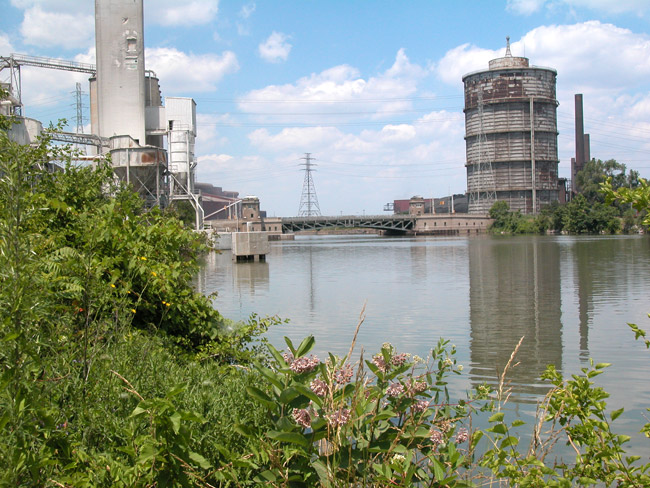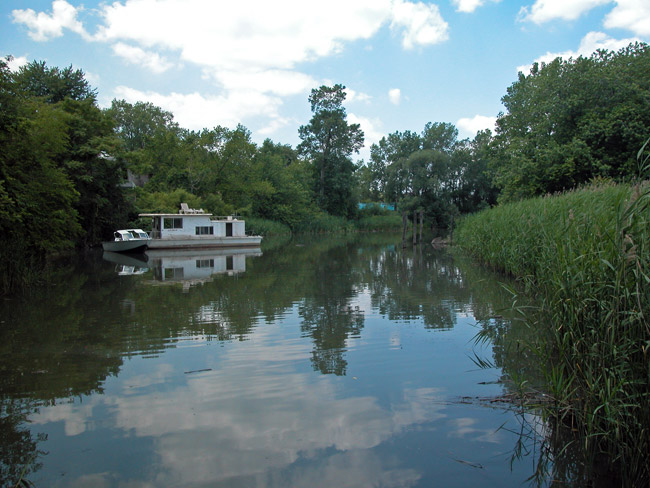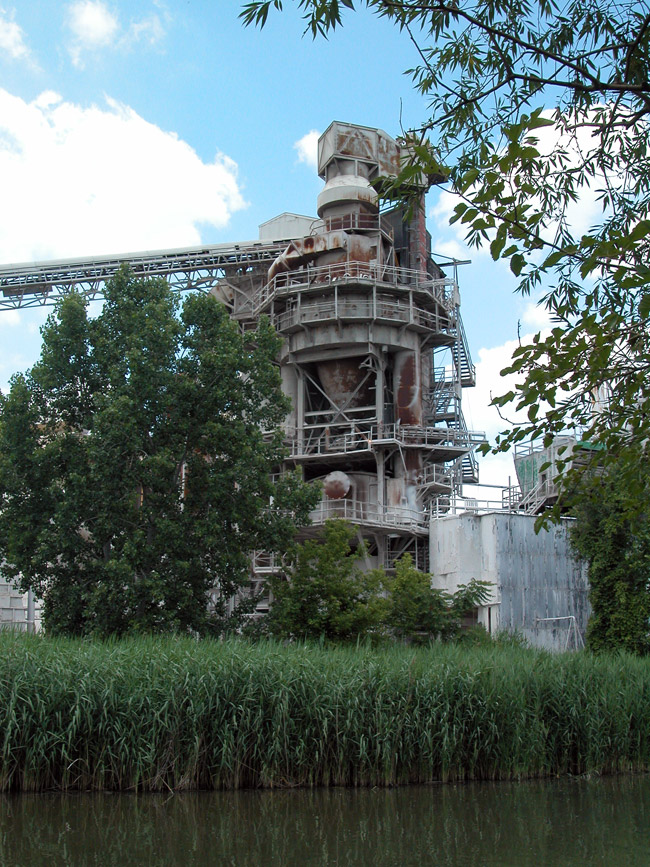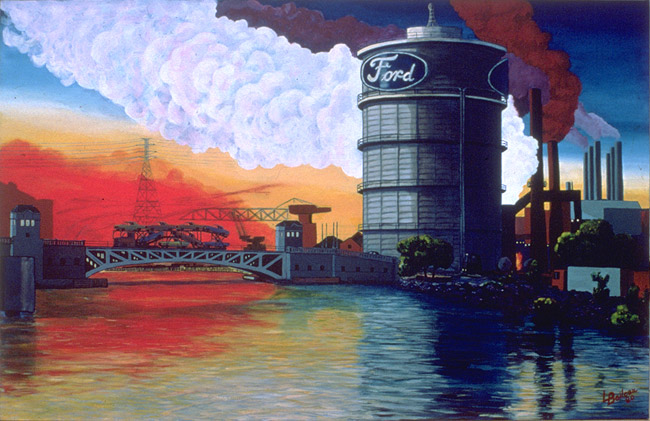A little gem of an island with its surrounding oxbow channel may see recovery from decades of neglect and industrial pollution according to recent media reports. Fordson Island was created during the industrialization of the lower Rouge River and today mainly serves as dockage for tug boats and barges.
The north end offered dramatic vistas of the Dix Street bridge opening to admit ore freighters into the mighty Ford Rouge complex. Until the 1990's an abandoned charming house existed at this point, but was later vandalized then destroyed.
To the west of the island is the oxbow channel that always had the feeling of pirate's cove with an assortment of beat-up and abandoned boats set in an idyllic setting so ironically peaceful compared to the industrial giants nearby.
What made the island miserable was the continual powdering of lime dust from the Levy Lime facility just across the oxbow. Shown in these pictures, taken in 2004, it towered over the island. Fortunately for the island and the adjacent Oakwood Heights neighborhood, it has since been demolished. Smoke and other pollutants from the Rouge complex to north and the river being little more than an industrial sewer further degraded the island's inhabitableness. Much has improved over the decades but soil and river remediation will be a huge task.
Forsdon Island has fascinated me since I first visited it in the 1970's. Later the site became the inspiration for this 38 x 55 inch 1980 painting simply title "Rouge". The cylindrical gasometer on the right that dominated this scene has since been demolished. Gone also is the power plant on the far right following explosions in 1999 that killed six workers.
Aerial View Click Here
Results 1 to 25 of 26
-
November-23-10, 08:09 AM #1
 DetroitYES
DetroitYES
- Join Date
- Feb 2009
- Posts
- 6,776
 Fordson Island Restoration Advances
Fordson Island Restoration Advances
-
November-23-10, 08:43 AM #2
 DetroitYES Member
DetroitYES Member
- Join Date
- Mar 2009
- Posts
- 207

There are conceptual plans to continue the Rouge Gateway trail from Michigan Avenue and the Rouge to Fordson Island and on to the Fort Street bridge. I have not heard any information on when this trail might come closer to reality. It would be a critical connector since it creates a clear bike route from Hines Drive to W. Vernor [[via Fort and Riverside) to Michigan Avenue and Downtown.
-
November-23-10, 02:55 PM #3
 DetroitYES Member
DetroitYES Member
- Join Date
- Apr 2009
- Posts
- 915

Is it possible to drive to the island? Is it gated or closed? I have seen the island on satellite views and wondered if i was strictly industrial or if there had been some homes on the island, etc. It's fascinating to see these pictures, to me the island is a total mystery.
-
November-23-10, 03:03 PM #4
 DetroitYES Member
DetroitYES Member
- Join Date
- Apr 2009
- Posts
- 619

This is a great post Lowell - what an interesting little spot. I prowled around it awhile back, but there is no way on to the island without permission.
http://www.detroitfunk.com/?p=1358
-
November-23-10, 03:08 PM #5
 DetroitYES Member
DetroitYES Member
- Join Date
- Mar 2009
- Posts
- 3,698

You can't presently go onto the island. You can drive right up to the road which is now blocked - or was, as of last week. Take Denmark to the Gaelic tug yard, turn left and go another block to ?Prescott?, whatever, the street is on your right and you'll see 'Treasure Island', as we called it as kids, the view as pictured in Lowell's 2nd photo. Stop at Gonnella's and get a sub. Say 'Hi' to Pete from Skipper.
-
November-23-10, 03:42 PM #6
 DetroitYES Member
DetroitYES Member
- Join Date
- Apr 2009
- Posts
- 915

Whenever I'm in that area, which is unfortunately not often, I make a trip to Gonella's without fail. Sometimes to the Bridge Cafe when I have drinking buds along.
-
November-23-10, 04:08 PM #7
 DetroitYES Member
DetroitYES Member
- Join Date
- Mar 2009
- Posts
- 217

From the NOAA archives, Detroit River charts:
Attachment 7853
Attachment 7854
There are more detailed charts for the Rouge River at
http://historicalcharts.noaa.gov/his...rical_zoom.asp
-
November-23-10, 06:03 PM #8
 DetroitYES
DetroitYES
- Join Date
- Feb 2009
- Posts
- 6,776

Nice find Hornwrecker. It never occurred to that the 'pirate's cove' side was the original river.
-
November-23-10, 06:47 PM #9
 DetroitYES Member
DetroitYES Member
- Join Date
- Dec 2009
- Posts
- 179

How did the name of the island come about? Named after Edsel?
-
November-23-10, 07:32 PM #10
 DetroitYES Member
DetroitYES Member
- Join Date
- Feb 2010
- Posts
- 4,215

Great post Lowell, great pics and a really nice painting full of the glamor of industry, and I say this without a trace of irony. The more I look at Detroit and what it means to the generations who have a heart to acknowledge the contributions, the efforts it took to bring about the automobile age, an attempt at perfecting our lives, it is very touching. Detroit has been shunned by outsiders and insiders alike, and yet; there is no getting around the respect for the effort that this city and its industrial might have bequeathed the world. There are many milestones in automotive history that were written in Detroit, the painful, the wise, the doctrinaire and the humanly possible side of industrial challenge. I think that other cities have not experienced the profound upheavals that Detroit has on that front. Detroit will be transformed into a collection of very subtle neighborhoods over time. The people of Detroit will need to revive some of the memories of this industrial past, but not to the point of repeating the drudgery, the pollution and the massiveness.I hope for a better more creative auto industry alongside other less invasive stuff, in a sense. The chinese and Indian powerhouses have fewer restrictions than we do, but they will have to reckon with the problems that we have had in our longer history of industrial activity. We can transform our environment and restore our industrial capability to compete, but let us not forget how humans thrive.
-
November-23-10, 07:49 PM #11
 DetroitYES Member
DetroitYES Member
- Join Date
- Mar 2009
- Posts
- 1,911

What is a cylindrical gasifier?
Great painting by the way.
-
November-23-10, 08:38 PM #12
 DetroitYES Member
DetroitYES Member
- Join Date
- Jun 2010
- Posts
- 571

Agreed wholeheartedly, but don't forget Windsor canuck All of the same happened here as well, and we get the same slap in the face from Canada as Detroit does from America. We put Canada on wheels and Windsor Ford workers dished out almost 600,000 military vehicles of the more than 900,000 built in Canada, making us the most highly mechanized Army in the world at the time, boasting 1 vehicle for every 3 soldiers in Europe! I'll quote this from a book I'm reading called "Pioneering the Auto age". if it was made in Canada, has 4 wheels and an engine, it was probably assembled, fabricated, moulded, cast, drilled, boared or painted in Windsor.
All of the same happened here as well, and we get the same slap in the face from Canada as Detroit does from America. We put Canada on wheels and Windsor Ford workers dished out almost 600,000 military vehicles of the more than 900,000 built in Canada, making us the most highly mechanized Army in the world at the time, boasting 1 vehicle for every 3 soldiers in Europe! I'll quote this from a book I'm reading called "Pioneering the Auto age". if it was made in Canada, has 4 wheels and an engine, it was probably assembled, fabricated, moulded, cast, drilled, boared or painted in Windsor.
I'm not trying to highjack the thread....I just don't like being left out of such an important peice of history.
Detroit and Windsor are so connected to eachother it's not even funny, especially when times are good.
And yes, great post and painting Lowell!
-
November-23-10, 09:11 PM #13
 DetroitYES Member
DetroitYES Member
- Join Date
- Feb 2010
- Posts
- 4,215

You,re absolutely right Magna, and not enough is said of canadian contributions to the car industry. I remember reading once that there were a total of maybe 200 small canadian automotive makers in the dawn of that industry. There were 600 car companies in north america roundabout 1920. Smaller companies disappeared or got gobbled up as we all know. A lot has changed since then. There was the high quality canadian McLaughlin automobile that was to become McLaughlin Buick. but of course Windsor and Detroit are both integrated as the iconic industrial center of motive power. In spite of the reversals of fortune; lets be positive and think about how they can make a comeback. There is plenty of opportunities still, what we need is ideas and a new frame of mind.
-
November-23-10, 09:20 PM #14
 DetroitYES Member
DetroitYES Member
- Join Date
- Jun 2010
- Posts
- 571

Don't worry, I know we'll both come back stronger than ever. We're in such a stratigic area, all we need it better options to cross the border. Just-in-time deliveries and 1/2 waits just don't mix. We also need to look at things other than automotive. Sometimes I wish the Big 3 would just come back home. It bothers me to no end that of all the cities they move their factories from, Windsor and Detroit are always on the list.

I'm tellin ya though, from a Windsor point of view, Canada sure feels like it ends at London as far as the Gov and major industry is concerned.
-
November-23-10, 10:57 PM #15
 DetroitYES Member
DetroitYES Member
- Join Date
- Mar 2009
- Posts
- 1,547

Cool thread! I love the pictures and painting Lowel. And the map that shows how the island was created is awesome.
-
November-23-10, 11:03 PM #16
 DetroitYES
DetroitYES
- Join Date
- Feb 2009
- Posts
- 6,776

I meant to write gasometer, now corrected in my post above. Gasometer pics.
and thanks for the kind remarks to all.
-
November-23-10, 11:17 PM #17
 DetroitYES
DetroitYES
- Join Date
- Feb 2009
- Posts
- 6,776

Windsor was very much a part of the auto revolution that took place along our mutual straits. And likewise it now suffers the scorn and derision that Detroit gets.
The way for our comeback is to come together. Detroit and Windsor are dead ends without each other. Our prosperity and mutual growth happened because our borders were relaxed, not sealed. We need a treaty that frees up our border, but respects the sovereignty of both sides. It can be done and we will all win when it happens.
-
November-24-10, 02:40 PM #18
 DetroitYES Member
DetroitYES Member
- Join Date
- Mar 2009
- Posts
- 3,698

It's not a cylindrical gasifier, it's a gasifier that's cylindrical shape - actually, a storage tank.That's the tall, round tower in the background of the picture, what were once known as 'Gas Is Best' tanks. 'Gas Is Best' was written on them in extraordinarily large, white letters and might've even been lighted. The area, due to it's long industrial history, was the center of heavy manufacturing and all of it's related businesses, such as Carbon Works, which is now directly under I-75. Carbon Works was a blue collar, clean, orderly neighborhood when I was a kid. It's now mostly deserted, except for the Carbon Club. I attempted to buy a building on the Rouge River a few years back. I was excited because I could walk out on the roof right to the river's edge. Ships passed by, a couple dozen yards away, on their way up and down the Rouge. It had a great room, almost all glass, with an overhead crane. The basement was below water level, but dry as a bone. Unfortunately, the history was so chemically laden, that it was very hazardous. I put together the EP-1A and most of the EP-2A research and consulted with environmental firms and attorneys. They all pretty much agreed: it would take years and huge investments to possibly make it inhabitable. But they'd still not recommend it for living or entertainment. It had been a coal-gasification facility during early in the century.
-
November-24-10, 02:49 PM #19
 DetroitYES Member
DetroitYES Member
- Join Date
- Mar 2009
- Posts
- 3,698

Windsor and Detroit - the twins. Both, historically very, very important to their respective countries and the world. Both, much maligned and despised because of their industries. Both, epicenters of industry, assimilation, hope and culture. Both, unique because of those reasons and geographic locations. The Detroit River, Lake St. Clair and Lake Erie make this a wonderful region. I'll take the rivers and lakes here in Michigan and Ontarion to the SF Bay and the ocean, any time.
-
November-24-10, 02:53 PM #20
 DetroitYES Member
DetroitYES Member
- Join Date
- Mar 2009
- Posts
- 3,698

BTW, the Rouge river was a winding river until Henry Ford decided to cut the short cut channels [[at the mouth and at Fordson Island) to facilitate ships moving to and from his Rouge Plant, which, contrary to popular opinion is not IN River Rouge, but is ON the River Rouge. Or, as we called it when growing up, da' Roodge.
-
November-25-10, 09:20 PM #21
 DetroitYES Member
DetroitYES Member
- Join Date
- Feb 2010
- Posts
- 4,215

Well, maybe this has to do with how much the white collar world has brought the economy of both Canada and the US to our knees. All these people who ended up in marketing and commerce schools and faculties, actually believing wealth is created on paper, far removed from the reality of making things with their hands or with machines. All these people who worship haute couture labels with very little interest in actual manual work are the ones who fuck up our economy. Look at where the office jobs are located and that is where the money and influence over politics has gone.
-
December-08-10, 07:00 AM #22littlebuddy Guest
 Fordson Island Cleanup
Fordson Island Cleanup
This was in today's Detroit News.
Fordson Island gets cleanup
Jim Lynch / The Detroit News
Detroit
Cynthia Whitehead has lived along Heidt Street, in what is almost the farthest southwest point of Detroit, for all of her 36 years and watched the view worsen. The neighborhood has deteriorated — with vacant properties, burned-down homes, crime and occasional rats.
She doesn't feel comfortable letting her children play outside. Adding to the dreariness is the 10-acre island — a manmade chunk of land several yards offshore in the Rouge River — that sits in full view of all Heidt Street residents. Over the years, this industrial property called Fordson Island has become a magnet for dumping and discarded boats.
"It's depressing," Whitehead said. "Every time you turn around people are constantly [[illegally) dumping garbage over there. That makes us look bad."
After years of neglect, Fordson Island soon will be seeing improvements and could represent a preliminary step in the reinvention of the Rouge River area. Work crews this week will begin dragging away carcasses of the decaying boats that dot the island shoreline in a cleanup effort spearheaded by the Detroit/Wayne County Port Authority.
The authority is allocating $150,000 in grant money — part of the Great Lakes Restoration Initiative — to help several organizations, including the Friends of the Rouge River and the Detroit Riverfront Conservancy, make something out of the eyesore.
"We're going to take that money and remove the abandoned vessels that have been left in the channel," said John Kerr, director of economic development for the authority. "Not to mention we'll be removing who knows what that's still in those vessels."
Island has potential
Dearborn Mayor John O'Reilly Jr. sees potential in the island that technically lies within his city's limits. Despite hurdles to rehabilitation, including soil contamination, Fordson Island could be the starting point for something big, said O'Reilly and several Downriver leaders.
O'Reilly said he sees Fordson Island as a "learning lab" for environmental sciences where students and researchers could evaluate cleanup processes as work continues to rehabilitate the soil, which contains traces of polychlorinated biphenyls and other contaminants left over from its industrial past.
"It could be a place where we achieve the goal of cleaning up the property but we also create a place for future scientists to say 'Let's try this,' or 'Let's try that,'" O'Reilly said.
Fordson Island also figures in the plans of other groups including the Southwest Detroit Business Association
who see the property as part of the Rouge Gateway Project — a collection of pathways and trails linking the waterfront areas along the river.
Other ideas include cleaning up the manmade channel for use as a kayaking destination and utilizing the area as a wildlife refuge. In a perfect world, O'Reilly said, the work along the Rouge River would eventually tie in with work already under way via the Detroit RiverFront Conservancy, which has built a RiverWalk in downtown Detroit.
"This creates the opportunity for us to take something that has just kind of been sitting there and giving it a purpose — making it a part of something larger," O'Reilly said. "With projects like this, we're seeing the transformation of the Rouge right before our eyes."
That would be welcome news for Whitehead.
"I'd be happy if they did just about anything, besides letting it be a dump site," the homeowner said.
The next step
Before any of that can happen, Marathon and the Michigan Department of Natural Resources and Environment will have to determine the extent of the soil contamination and how best to tackle it.
The island may lie in Dearborn, but a one-lane bridge to it is in Detroit. Despite its size, the island has multiple owners, including Marathon Petroleum and the city of Dearborn.
Marathon has owned roughly half the island since 1959, when it was known as the Ohio Oil Co. and purchased a 5.5-acre parcel from businessman Max Fisher. At that time, the property included an oil refinery operation. Later, Marathon would use the land for a marine loading facility, but that operation has not been used since 2003. The Faust Corp., a St. Clair Shores-based marine and land construction company, is the only entity operating on the island today. Faust leases the property from a private firm.
Abandoned boats abound
In recent years, Fordson Island has become a magnet for boats no one seems to want. All manner of crafts of varying shapes and sizes lie rusted-out and beached along the island's south side channel. That includes one entire decaying houseboat in full view of the surrounding neighborhood. And the channel appears to be filled with refuse.
The full extent of the environmental contamination is unknown. State officials are waiting for an assessment of the land conducted by Marathon to arrive, possibly as early as January. At that point, a remediation plan can be devised that would open the door to the next chapter in the island's already-unusual history.
Before 1922, there was no Fordson Island. It was simply part of the southern shore along the Rouge River. In an attempt to improve shipping — particularly to and from the Ford Rouge Plant — engineers cut a channel across the land. That $10 million project, in conjunction with dredging of the newly created channel — proved crucial as the Rouge Plant began manufacturing Eagle-class patrol boats designed to hunt German submarines.
During Prohibition, boats bringing in illegal alcohol from Canada would land at Fordson Island to offload their cargo and avoid law enforcement agents, who had staked out normal landing spots along the Detroit River.
Now, officials like O'Reilly are looking to add a new chapter to Fordson's history.
"We really think we could turn the Rouge into a place where people want to come up the river to see what's going on," he said.
"This is the birthplace of an industry. And [[Fordson) island was a part of that."
From The Detroit News
-
December-08-10, 01:21 PM #23
 DetroitYES Member
DetroitYES Member
- Join Date
- Mar 2009
- Posts
- 1,547

Interesting reading. But I rather like the Sargasso Sea lost boat grave yard look.
-
December-28-10, 06:05 PM #24
 DetroitYES Member
DetroitYES Member
- Join Date
- Mar 2009
- Posts
- 1,547

Here are some newer arial pictures from the Detroit News. It's amazing how just a few trees makes that part of the river look so bucolic.
http://multimedia.detnews.com/pix/ph...and/index.html
-
December-29-10, 03:08 PM #25
 DetroitYES Member
DetroitYES Member
- Join Date
- Mar 2009
- Posts
- 3,698

Thanks for the photo, Blind, Sonny, Junior Boy, Little Ricky. As I've said before, my brother lived in that neighborhood [[Oakwood) about 30 years ago. It wasn't a bad neighborhood. Homes along the lines of Hamtown, Allen Park, etc. Nice yards, clean streets. Young people living in flats like in Hamtown. I visit there once every couple of weeks while getting my downriviera jones satisfied. Nope, no crack, just Gonella's, Weyand's, Armando's etc. I now have a nice aerial photo for a reminder.
Welcome to DetroitYES! Kindly Consider Turning Off Your Ad BlockingX
DetroitYES! is a free service that relies on revenue from ad display [regrettably] and donations. We notice that you are using an ad-blocking program that prevents us from earning revenue during your visit.
Ads are REMOVED for Members who donate to DetroitYES! [You must be logged in for ads to disappear]
Ads are REMOVED for Members who donate to DetroitYES! [You must be logged in for ads to disappear]
DONATE HERE »
And have Ads removed.
And have Ads removed.









 Reply With Quote
Reply With Quote



Bookmarks